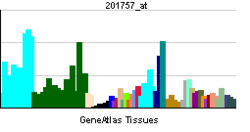- NDUFS5
-
NADH dehydrogenase [ubiquinone] iron-sulfur protein 5 is an enzyme that in humans is encoded by the NDUFS5 gene.[1][2][3]
References
- ^ Emahazion T, Beskow A, Gyllensten U, Brookes AJ (Nov 1998). "Intron based radiation hybrid mapping of 15 complex I genes of the human electron transport chain". Cytogenet Cell Genet 82 (1–2): 115–9. doi:10.1159/000015082. PMID 9763677.
- ^ Mao M, Fu G, Wu JS, Zhang QH, Zhou J, Kan LX, Huang QH, He KL, Gu BW, Han ZG, Shen Y, Gu J, Yu YP, Xu SH, Wang YX, Chen SJ, Chen Z (Aug 1998). "Identification of genes expressed in human CD34(+) hematopoietic stem/progenitor cells by expressed sequence tags and efficient full-length cDNA cloning". Proc Natl Acad Sci U S A 95 (14): 8175–80. doi:10.1073/pnas.95.14.8175. PMC 20949. PMID 9653160. http://www.pubmedcentral.nih.gov/articlerender.fcgi?tool=pmcentrez&artid=20949.
- ^ "Entrez Gene: NDUFS5 NADH dehydrogenase (ubiquinone) Fe-S protein 5, 15kDa (NADH-coenzyme Q reductase)". http://www.ncbi.nlm.nih.gov/sites/entrez?Db=gene&Cmd=ShowDetailView&TermToSearch=4725.
Further reading
- Loeffen JL, Triepels RH, van den Heuvel LP, et al. (1999). "cDNA of eight nuclear encoded subunits of NADH:ubiquinone oxidoreductase: human complex I cDNA characterization completed". Biochem. Biophys. Res. Commun. 253 (2): 415–22. doi:10.1006/bbrc.1998.9786. PMID 9878551.
- Loeffen J, Smeets R, Smeitink J, et al. (1999). "The human NADH: ubiquinone oxidoreductase NDUFS5 (15 kDa) subunit: cDNA cloning, chromosomal localization, tissue distribution and the absence of mutations in isolated complex I-deficient patients". J. Inherit. Metab. Dis. 22 (1): 19–28. doi:10.1023/A:1005434912463. PMID 10070614.
- Zhang QH, Ye M, Wu XY, et al. (2001). "Cloning and functional analysis of cDNAs with open reading frames for 300 previously undefined genes expressed in CD34+ hematopoietic stem/progenitor cells". Genome Res. 10 (10): 1546–60. doi:10.1101/gr.140200. PMC 310934. PMID 11042152. http://www.pubmedcentral.nih.gov/articlerender.fcgi?tool=pmcentrez&artid=310934.
- Triepels RH, Hanson BJ, van den Heuvel LP, et al. (2001). "Human complex I defects can be resolved by monoclonal antibody analysis into distinct subunit assembly patterns". J. Biol. Chem. 276 (12): 8892–7. doi:10.1074/jbc.M009903200. PMID 11112787.
- Strausberg RL, Feingold EA, Grouse LH, et al. (2003). "Generation and initial analysis of more than 15,000 full-length human and mouse cDNA sequences". Proc. Natl. Acad. Sci. U.S.A. 99 (26): 16899–903. doi:10.1073/pnas.242603899. PMC 139241. PMID 12477932. http://www.pubmedcentral.nih.gov/articlerender.fcgi?tool=pmcentrez&artid=139241.
- Gerhard DS, Wagner L, Feingold EA, et al. (2004). "The status, quality, and expansion of the NIH full-length cDNA project: the Mammalian Gene Collection (MGC)". Genome Res. 14 (10B): 2121–7. doi:10.1101/gr.2596504. PMC 528928. PMID 15489334. http://www.pubmedcentral.nih.gov/articlerender.fcgi?tool=pmcentrez&artid=528928.
- Huang G, Chen Y, Lu H, Cao X (2007). "Coupling mitochondrial respiratory chain to cell death: an essential role of mitochondrial complex I in the interferon-beta and retinoic acid-induced cancer cell death". Cell Death Differ. 14 (2): 327–37. doi:10.1038/sj.cdd.4402004. PMID 16826196.
Categories:- Human proteins
- Chromosome 1 gene stubs
Wikimedia Foundation. 2010.

